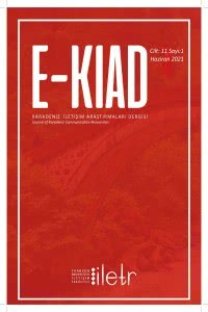REKLAMDA ABSÜRTLÜĞÜN REKLAMA YÖNELİK TUTUM VE HATIRLAMA ÜZERİNE ETKİLERİ
Absürt, reklam, reklama yönelik tutum, hatırlama
EFFECTS OF ABSURDITY IN ADVERTISING ON ATTITUDE TOWARD THE AD AND RECALL
Absurdity, advertising, attitude toward the ad, recall,
___
- Aggarwal, P. & McGill, A. (2007). Is that car smiling at me? Schema congruity as a basis for evaluating anthropomorphized products. Journal of Consumer Research, 34 (4), 468 – 479.
- Arias-Bolzmann, L. (1993). An empirical investigation of absurdism's impact on consumer responses to print advertising. Yayınlanmamış Doktora Tezi. Oklahoma State University.
- Arias-Bolzmann, L., Chakraborty, G. & Mowen, J. C. (2000). Effects of absurdity in advertising: The moderating role of product category attitude and the mediating role of cognitive responses. Journal of Advertising. 29 (1), 35 – 49.
- Baysal, A. (2008). Piyanoya ters oturup klozet çalan inek ya da absürd reklamcılık. Yeni Pazarlama Trendleri. (Ed: A. Baysal). (3. Baskı). İstanbul: MediaCat.
- Biehal, G., Stephens, D. & Curlo, E. (1992). Attitude toward the ad and brand choice. Journal of Advertising 21 (3) 19 – 36.
- Callister, M. A. & Stern, L. A. (2007). The role of visual hyperbole in advertising effectiveness. Journal of Current Issues and Research in Advertising, 29 (2), 1 – 14.
- Cevizci, A. (2005). Paradigma felsefe sözlüğü. (6. Basım). İstanbul: Paradigma.
- Çalışkan, H. (1995). Absürt tiyatro. Ankara : İmge Kitabevi.
- Delbaere, M., McQuarrie, E. F. & Phillips, B. J. (2011). Personification in Advertising. Journal of Advertising, 40 (1), 121 – 130.
- Eken, İ. (2011). Reklamda absürtlüğün etkileri: bilişsel tepkilerin yön verici rolü. Yayınlanmamış Yüksek Lisans Tezi. İstanbul: Bahçeşehir Üniversitesi.
- Esslin, M. (1999). Absürd Tiyatro. (Çev: G. Siper). Ankara: Dost.
- Gelbrich, K., Gäthke, D. & Westjohn, S. A. (2012a). Effectiveness of absurdity in advertising across cultures. Journal of Promotion Management, 18 (4), 393 – 413.
- Gelbrich, K., Gäthke, D. & Westjohn, S. A. (2012b). Anthropomorphism and allegory in advertising across cultures: Effects on memory and persuasion Journal of Euromarketing, 21, 174 – 191.
- Gündoğan, A. O. (1995). Albert Camus ve baş kaldırma felsefesi. Erzurum: Birey.
- Heckler, S. E., & Childers, T. L. (1992). The role of expectancy and relevancy in memory for verbal and visual information. What is incongruency? Journal of Consumer Research, 18 (4), 475 – 492.
- Homer, P. M. (1986). Surrealism and advertising: A test of alternative explanations. Yayınlanmamış Doktora Tezi. University of Oregon.
- Homer, P. M., & Kahle, L. R. (1986). A social adaption explanation of the effects of surrealism on advertising. Journal of Advertising, 15 (2), 50 – 60.
- Karasar, N. (2008). Bilimsel araştırma yöntemi. (18. Baskı). Ankara: Nobel.
- Lynch, J. & Srull, T. (1982). Memory and attentional factors in consumer choice: Concepts and research methods. Journal of Consumer Research, 9 (1), 18-37.
- MacKenzie, S. B. & Lutz, R. J. (1989). An empirical examination of the structural antecedents of attitude toward the ad in an advertising pretesting context. Journal of Marketing, 53 (2), 48 – 65.
- MacKenzie, S. B., Lutz, R. J. & Belch, G. E. (1986). The role of attitude toward the ad as a mediator of advertising effectiveness: a test of competing explanations. Journal of Marketing Research, 23 (2), 130 – 143.
- Neuman, W. L. (2010). Toplumsal araştırma yöntemleri: nitel ve nicel yaklaşımlar. (Çev: S. Özge). (4. Basım). İstanbul: Yayın Odası.
- Öztek, M. Y. (2005). Reklam etkinlikleri açısından post-testlerin önemi ve bir uygulama. Yönetim: İstanbul Üniversitesi İşletme Fakültesi İşletme İktisadı Enstitüsü Dergisi, 16 (52), 3 – 6.
- Pieters, R., Warlop, L., & Wedel, M. (2002). Breaking through the clutter: Benefits of advertisement originality and familiarity for brand attention and memory. Management Science, 48 (6), 765 – 781.
- Püsküllüoğlu, A. (2004). Türkçedeki yabancı sözcükler sözlüğü. (5. Basım). Ankara: Arkadaş Yayınevi.
- Rossiter, J. R. & Percy, L. (1997). Advertising communications and promotion management. (2nd Edition) Boston: Irwin / McGraw-Hill.
- Stern, B. B. (1988). Medieval allegory: roots of advertising strategy for the mass market. Journal of Marketing, 52 (3), 84 – 94.
- Stern, B. B. (1990). Marketing as drama: theatre of the absurd. Research in Consumer Behaviour, 4. 189 – 209.
- Stern, B. B. (1992). Crafty advertisers: literary versus literal deceptiveness. Journal of Public Policy and Marketing, 11 (1), 72 – 81.
- Şener, S. (1991). Dünden bugüne tiyatro düşüncesi. Eskişehir: Anadolu Üniversitesi Devlet Konservatuvarı Yayınları.
- Uztuğ, F. (2009). Reklamcılıkta Anna Karenina ilkesi. İstanbul: Beslenme Saati. Wimmer, R. D. & Dominick, J. R. (2006). Mass media research : an introduction. (8th Edition). Australia : Thomson/Wordsworth.
- Zaichkowsky, J. L. (1994). The personal involvement inventory: reduction, revisio
- ISSN: 2146-3212
- Başlangıç: 2011
- Yayıncı: Karadeniz Teknik Üniversitesi
OYUNCU MOTİVASYONLARININ ADVERGAME UYGULAMALARI AÇISINDAN DEĞERLENDİRİLMESİ
Mesude Canan ÖZTÜRK, Engin COŞKUN
AHMET HAKAN’IN TARAFSIZ BÖLGE PROGRAMI ÜZERİNDEN MEDYADA KADIN TEMSİLİ SORUNU
İNTERNET REKLAMLARI KABULÜNÜ ETKİLEYEN FAKTÖRLER
YASADIŞI YAYINCILIKTAN TİCARİLEŞMEYE: FRANSA’DA KORSAN RADYOCULUĞUN KISA TARİHİ
REKLAMDA ABSÜRTLÜĞÜN REKLAMA YÖNELİK TUTUM VE HATIRLAMA ÜZERİNE ETKİLERİ
HAZIRAN 2015 GENEL SEÇIMLERINDE TWITTER GÜNDEMINI BELIRLEME. BIR SOSYAL AĞ ANALIZI UYGULAMASI
